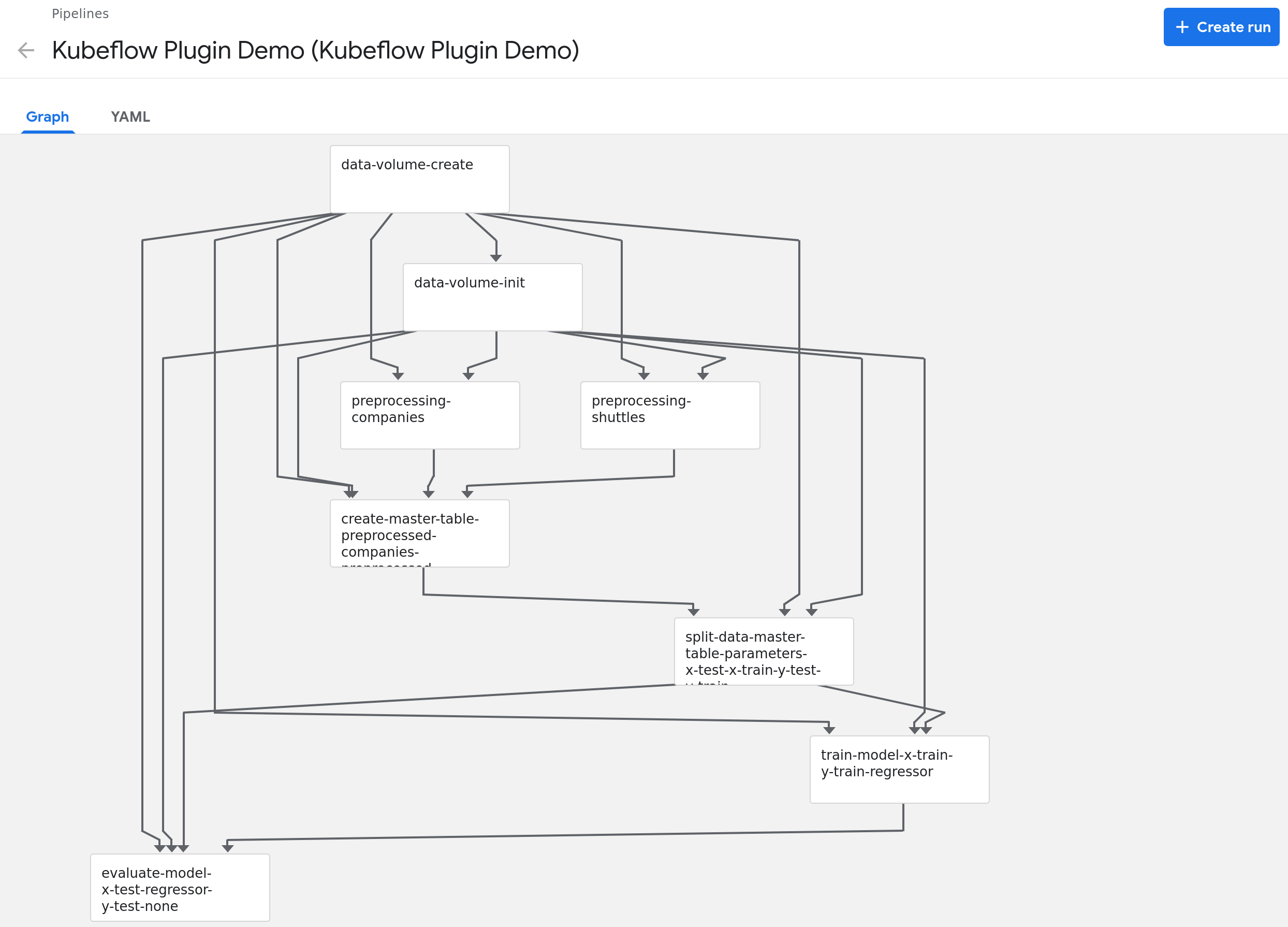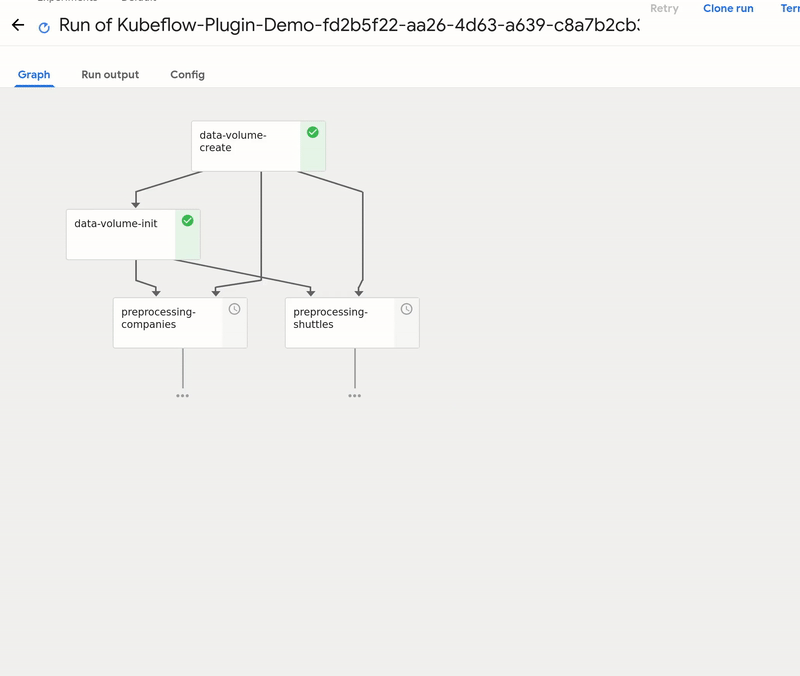Quickstart
Prerequisites
The quickstart assumes user have access to Kubeflow Pipelines deployment. Pipelines can be deployed on any Kubernetes cluster, including local cluster.
Local kubeflow cluster
There is also an option to test locally with running Kubernetes in docker (kind). After going through that guide you should have Kubeflow up and running available at http://localhost:9000.
Install the toy project with Kubeflow Pipelines support
It is a good practice to start by creating a new virtualenv before installing new packages. Therefore, use virtalenv command to create new env and activate it:
$ virtualenv venv-demo
created virtual environment CPython3.8.5.final.0-64 in 145ms
creator CPython3Posix(dest=/home/mario/kedro/venv-demo, clear=False, no_vcs_ignore=False, global=False)
seeder FromAppData(download=False, pip=bundle, setuptools=bundle, wheel=bundle, via=copy, app_data_dir=/home/mario/.local/share/virtualenv)
added seed packages: pip==20.3.1, setuptools==51.0.0, wheel==0.36.2
activators BashActivator,CShellActivator,FishActivator,PowerShellActivator,PythonActivator,XonshActivator
$ source venv-demo/bin/activate
Then, kedro must be present to enable cloning the starter project, along with the latest version of kedro-kubeflow plugin and kedro-docker (required to build docker images with the Kedro pipeline nodes):
$ pip install 'kedro<0.19.0,>0.18.1' kedro-kubeflow kedro-docker
With the dependencies in place, let’s create a new project (with the latest supported kedro version - 0.17.7):
$ kedro new --starter=spaceflights --checkout=0.17.7
Project Name:
=============
Please enter a human readable name for your new project.
Spaces and punctuation are allowed.
[New Kedro Project]: Kubeflow Plugin Demo
Repository Name:
================
Please enter a directory name for your new project repository.
Alphanumeric characters, hyphens and underscores are allowed.
Lowercase is recommended.
[kubeflow-plugin-demo]:
Python Package Name:
====================
Please enter a valid Python package name for your project package.
Alphanumeric characters and underscores are allowed.
Lowercase is recommended. Package name must start with a letter or underscore.
[kubeflow_plugin_demo]:
Change directory to the project generated in /home/mario/kedro/kubeflow-plugin-demo
A best-practice setup includes initialising git and creating a virtual environment before running `kedro install` to install project-specific dependencies. Refer to the Kedro documentation: https://kedro.readthedocs.io/
Next go the demo project directory:
$ cd kubeflow-plugin-demo/
Before installing the dependencies, add the kedro-kubeflow to requirements.* in src:
$ echo kedro-kubeflow >> src/requirements*
Finally, ensure that kedro-kubeflow plugin is activated:
$ pip install -r src/requirements.txt
(...)
Requirements installed!
$ kedro kubeflow --help
Usage: kedro kubeflow [OPTIONS] COMMAND [ARGS]...
Interact with Kubeflow Pipelines
Options:
-e, --env TEXT Environment to use.
-h, --help Show this message and exit.
Commands:
compile Translates Kedro pipeline into YAML file with Kubeflow...
init Initializes configuration for the plugin
list-pipelines List deployed pipeline definitions
mlflow-start
run-once Deploy pipeline as a single run within given experiment.
schedule Schedules recurring execution of latest version of the...
ui Open Kubeflow Pipelines UI in new browser tab
upload-pipeline Uploads pipeline to Kubeflow server
Build the docker image to be used on Kubeflow Pipelines runs
First, initialize the project with kedro-docker configuration by running:
$ kedro docker init
This command creates a several files, including .dockerignore. This file ensures that transient files are not included in the docker image and it requires small adjustment. Open it in your favorite text editor and extend the section # except the following by adding there:
$ echo !data/01_raw >> .dockerignore
This change enforces raw data existence in the image. Also, one of the limitations of running the Kedro pipeline on Kubeflow (and not on local environemt) is inability to use MemoryDataSets, as the pipeline nodes do not share memory, so every artifact and intermediate data step should be stored as a file. The spaceflights demo configures four datasets as in-memory, so we need to change that. Replace the conf/base/catalog.yml with the following:
companies:
type: pandas.CSVDataSet
filepath: data/01_raw/companies.csv
layer: raw
reviews:
type: pandas.CSVDataSet
filepath: data/01_raw/reviews.csv
layer: raw
shuttles:
type: pandas.ExcelDataSet
filepath: data/01_raw/shuttles.xlsx
layer: raw
load_args:
engine: openpyxl
data_processing.preprocessed_companies:
type: pandas.ParquetDataSet
filepath: data/02_intermediate/preprocessed_companies.pq
layer: intermediate
data_processing.preprocessed_shuttles:
type: pandas.ParquetDataSet
filepath: data/02_intermediate/preprocessed_shuttles.pq
layer: intermediate
model_input_table:
type: pandas.ParquetDataSet
filepath: data/03_primary/model_input_table.pq
layer: primary
data_science.active_modelling_pipeline.regressor:
type: pickle.PickleDataSet
filepath: data/06_models/regressor_active.pickle
versioned: true
layer: models
data_science.candidate_modelling_pipeline.regressor:
type: pickle.PickleDataSet
filepath: data/06_models/regressor_candidate.pickle
versioned: true
layer: models
data_science.active_modelling_pipeline.X_train:
type: pickle.PickleDataSet
filepath: data/05_model_input/X_train.pickle
layer: model_input
data_science.active_modelling_pipeline.y_train:
type: pickle.PickleDataSet
filepath: data/05_model_input/y_train.pickle
layer: model_input
data_science.active_modelling_pipeline.X_test:
type: pickle.PickleDataSet
filepath: data/05_model_input/X_test.pickle
layer: model_input
data_science.active_modelling_pipeline.y_test:
type: pickle.PickleDataSet
filepath: data/05_model_input/y_test.pickle
layer: model_input
data_science.active_modelling_pipeline.regressor:
type: pickle.PickleDataSet
filepath: data/06_models/regressor.pickle
versioned: true
layer: models
data_science.candidate_modelling_pipeline.X_train:
type: pickle.PickleDataSet
filepath: data/05_model_input/X_train.pickle
layer: model_input
data_science.candidate_modelling_pipeline.y_train:
type: pickle.PickleDataSet
filepath: data/05_model_input/y_train.pickle
layer: model_input
data_science.candidate_modelling_pipeline.X_test:
type: pickle.PickleDataSet
filepath: data/05_model_input/X_test.pickle
layer: model_input
data_science.candidate_modelling_pipeline.y_test:
type: pickle.PickleDataSet
filepath: data/05_model_input/y_test.pickle
layer: model_input
data_science.candidate_modelling_pipeline.regressor:
type: pickle.PickleDataSet
filepath: data/06_models/regressor.pickle
versioned: true
layer: models
Finally, build the image:
$ kedro docker build
When execution finishes, your docker image is ready. If you don’t use local cluster, you should push the image to the remote repository:
$ docker tag kubeflow-plugin-demo:latest remote.repo.url.com/kubeflow-plugin-demo:latest
$ docker push remote.repo.url.com/kubeflow-plugin-demo:latest
Local cluster testing
The kind has its own docker registry that you need to upload the image to. However, since it does not have any connection to other registry we want to prevent it from trying to pull any image (see the docs). In order to do that, we need to tag the built docker image with any specific version. Let’s use demo tag, as any tag other than latest will do.
Locate your image name (it should be the same as kedro project name) with:
$ docker images
Then tag your image with the following command:
$ docker tag <image>:latest <image>:demo
Then you need to upload the image from local registry to the kind registry. Here kfp is the cluster name (the same as in linked guide. Default cluster name is kind.
$ kind load docker-image <image>:demo --name kfp
Run the pipeline on Kubeflow
First, run init script to create the sample configuration. A parameter value should reflect the kubeflow base path as seen from the system (so no internal Kubernetes IP unless you run the local cluster):
$ kedro kubeflow init https://kubeflow.cluster.com
(...)
Configuration generated in /home/user/kedro/kubeflow-plugin-demo/conf/base/kubeflow.yaml
Local cluster testing
For local cluster the link is the following: http://localhost:9000
Warning
Since kedro 0.17 there have been introduced name spaces to datasets which are not yet fully supported by this plugin as it causes issues within naming conventions of kfp artifacts. For now it’s best to disable storage of kfp artifacts by adding/uncommenting the following line in conf/base/kubeflow.yaml:
store_kedro_outputs_as_kfp_artifacts: False
Then, if needed, adjust the conf/base/kubeflow.yaml. For example, the image: key should point to the full image name (like remote.repo.url.com/kubeflow_plugin_demo:latest if you’ve pushed the image at this name). Depending on the storage classes availability in Kubernetes cluster, you may want to modify volume.storageclass and volume.access_modes (please consult with Kubernetes admin what values should be there).
Local cluster testing
In this example you also need to update the tag of the image: part to also use demo instead latest.
Finally, everything is set to run the pipeline on Kubeflow. Run upload-pipeline:
$ kedro kubeflow upload-pipeline
2021-01-12 09:47:35,132 - kedro_kubeflow.kfpclient - INFO - No IAP_CLIENT_ID provided, skipping custom IAP authentication
2021-01-12 09:47:35,209 - kedro_kubeflow.kfpclient - INFO - Pipeline created
2021-01-12 09:47:35,209 - kedro_kubeflow.kfpclient - INFO - Pipeline link: https://kubeflow.cluster.com/#/pipelines/details/9a3e4e16-1897-48b5-9752-d350b1d1faac/version/9a3e4e16-1897-48b5-9752-d350b1d1faac
As you can see, the pipeline was compiled and uploaded into Kubeflow. Let’s visit the link:

The Kubeflow pipeline reflects the Kedro pipeline with two extra steps:
data-volume-create- creates an empty volume in Kubernetes cluster as a persistence layer for inter-steps data accessdata-volume-init- initialized the volume with01_rawdata when the pipeline starts
By using Create run button you can start a run of the pipeline on the cluster. A run behaves like kedro run command, but the steps are executed on the remote cluster. The outputs are stored on the persistent volume, and passed as the inputs accordingly to how Kedro nodes need them.

Tip
You can also schedule a single run by using
$ kedro kubeflow run-once
From the UI you can access the logs of the execution. If everything seems fine, use `schedule to create a recurring run:
$ kedro kubeflow schedule --cron-expression '0 0 4 * * *'
(...)
2021-01-12 12:37:23,086 - kedro_kubeflow.kfpclient - INFO - No IAP_CLIENT_ID provided, skipping custom IAP authentication
2021-01-12 12:37:23,096 - root - INFO - Creating experiment Kubeflow Plugin Demo.
2021-01-12 12:37:23,103 - kedro_kubeflow.kfpclient - INFO - New experiment created: 2123c082-b336-4093-bf3f-ce73f68b66b4
2021-01-12 12:37:23,147 - kedro_kubeflow.kfpclient - INFO - Pipeline scheduled to 0 0 4 * * *
You can see that the new experiment was created (that will group the runs) and the pipeline was scheduled. Please note, that Kubeflow uses 6-places cron expression (as opposite to Linux’s cron with 5-places), where first place is the second indicator.
